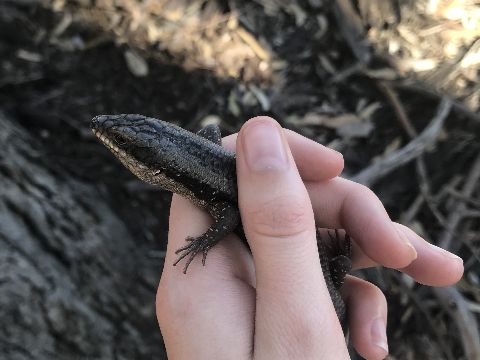- Charles Sturt University research uses artificial bark covers (ABCs) in lizard research in the Riverina flood plain
- The research assessed whether and how non-destructive artificial bark might be cost-effective and practical for monitoring some lizard populations
- Using artificial bark for research is a new technique and there is further scope to determine what conditions best suit finding a particular species
Research by a Charles Sturt University student is helping to define arboreal lizard populations in the Riverina flood plain and test the usefulness of artificial materials for them to shelter under.
Honours student Ms Eva Moore (pictured, inset) in the Charles Sturt School of Agricultural, Environmental and Veterinary Sciences said the main purpose of her research was to establish the usefulness of artificial bark covers (ABCs) in lizard research.
“Many arboreal species are dependent on exfoliating bark for shelter, thermoregulation, and foraging sites,” Ms Moore said.
“For example, nocturnal arboreal geckos will use bark to thermoregulate by changing their posture to maximise contact with the substrate while remaining beneath the safety of cover.
“The research tests the external factors that affect the usefulness of artificial bark for this type of research and helps to determine the distribution and population size of these lizard species.
“There is further scope to examine what conditions best suit finding a particular species, but it’s still a fairly novel technique so I had to determine what issues and problems needed to be addressed and resolved.”
Ms Moore co-authored a paper about the research with academics in the Charles Sturt School of Agricultural, Environmental and Veterinary Sciences, Associate Professor Dale Nimmo and Associate Professor Skye Wassens, and Senior Research Fellow in Ecology in the Gulbali Institute for Agriculture, Water and Environment Dr Damian Michael.
 The paper, ‘Use
of artificial bark covers to investigate the distribution and abundance of
arboreal lizards in a floodplain environment’ was published in the Australian Journal of Zoology (published 12 May 2022).
The paper, ‘Use
of artificial bark covers to investigate the distribution and abundance of
arboreal lizards in a floodplain environment’ was published in the Australian Journal of Zoology (published 12 May 2022).
The study shows that artificial bark covers are an effective method for compiling an inventory of arboreal lizards in a floodplain system and could be used across other dynamic ecosystems to better understand arboreal lizard distribution patterns.
Ms Moore said the ABCs may also be a useful tool in long-term monitoring programs as they are less destructive than traditional active search methods which often require some level of microhabitat disturbance.
Ms Moore grew up in Mount Gambier, South Australia, and moved to Wagga Wagga in 2017 to study a Bachelor of Animal Science. She finished her Honours year and research in 2020 and is now based in Albury.
She said she was looking for an Honours research project to work with Professor Wassens, and possibly frogs, and was introduced to Dr Michael who had the concept for the non-destructive artificial bark and how it might be cost-effective and useful for monitoring lizards.
 “I wanted a project that would give me plenty of hands-on fieldwork experience,” Ms Moore said.
“I wanted a project that would give me plenty of hands-on fieldwork experience,” Ms Moore said.
“Being able to physically check the ABCs and then collect data on the creatures found inside sounded like too good an opportunity to pass up.
“I’ve been interested in smaller amphibians and reptiles for a long time, so it was an excellent fit and very interesting throughout the research process.”
Since finishing the arboreal lizards and ABCs research project Ms Moore has joined Professor Wassen’s Murrumbidgee Monitoring and Research (MER) project as the technical officer.
“I’ve been working on the MER project for just under a year and my contract has been renewed for a second season,” she said.
“Essentially, I organise and maintain the equipment, plan the field trips, and help conduct the field trips so I still get lots of hands-on research experience, only now I’m catching fish, frogs and turtles.
“Before I started working in Albury I was considering going back to studying and potentially doing a PhD, but for now I’m happy working in this project with the people I met in my Honours year.”






Social
Explore the world of social